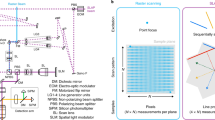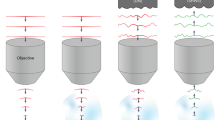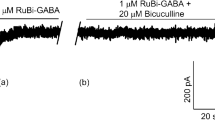Abstract
Photolysis of caged compounds is a powerful tool for studying subcellular physiological functions. Here we describe protocols for the alignment and calibration of a focal uncaging system. We also report procedures for convenient quantitative calibration of uncaging. Using these methods, we can achieve submicron lateral resolution of photolysis and probe biological function in spines, the smallest signaling compartments of neurons. Initially, the entire alignment procedure takes 4–6 h to perform; periodic fine-tuning of the system takes 1–2 h.
This is a preview of subscription content, access via your institution
Access options
Subscribe to this journal
Receive 12 print issues and online access
$259.00 per year
only $21.58 per issue
Buy this article
- Purchase on Springer Link
- Instant access to full article PDF
Prices may be subject to local taxes which are calculated during checkout



Similar content being viewed by others
References
Kaplan, J.H., Forbush, B. & Hoffman, J.F. Rapid photolytic release of adenosine 5′-triphosphate from a protected analogue: utilization by the Na:K pump of human red blood cell ghosts. Biochemistry 17, 1929–1935 (1978).
Adams, S.R. & Tsien, R.Y. Controlling cell chemistry with caged compounds. Annu. Rev. Physiol. 55, 755–784 (1993).
Marriott, G. (ed.) in Methods Enzymology 291 (Academic Press, New York, 1998).
Loudwig, S. & Bayley, H. in Dynamic Studies in Biology: Phototriggers, Photoswitches and Caged Biomolecules (eds Goeldner, M. & Givens, R.) 253–304 (Wiley-VCH, Verlag, 2005).
Kramer, R.H., Chambers, J.J. & Trauner, D. Photochemical tools for remote control of ion channels in excitable cells. Nature Chem. Biol. 1, 360–365 (2005).
Shoham, S., O'Connor, D.H., Sarkisov, D.V. & Wang, S.S.-H. Rapid neurotransmitter uncaging in spatially defined patterns. Nature Methods 2, 837–843 (2005).
Pettit, D.L., Wang, S.S.-H., Gee, K.R. & Augustine, G.J. Chemical two-photon uncaging: a novel approach to mapping glutamate receptors. Neuron 19, 465–471 (1997).
Kasai, H., Matsuzaki, M. & Ellis-Davies, G.C.R. in Imaging in Neuroscience and Development: A Laboratory Manual 3rd edn (eds Yuste, R. & Konnerth, A.) 375–383 (Cold Spring Harbor Laboratory Press, Cold Spring Harbor, New York, 2005).
Khodakhah, K. & Armstrong, C.M. Inositol trisphosphate and ryanodine receptors share a common functional Ca2+ pool in cerebellar Purkinje neurons. Biophys. J. 73, 3349–3357 (1997).
Khodakhah, K. & Ogden, D. Fast activation and inactivation of inositol trisphosphate-evoked Ca2+ release in rat cerebellar Purkinje neurones. J. Physiol. 487, 343–358 (1995).
Yasuda, R. et al. Imaging calcium concentration dynamics in small neuronal compartments. Sci. STKE 2004, pl5 (2004).
Wang, S.S.-H. & Augustine, G.J. Confocal imaging and local photolysis of caged compounds: dual probes of synaptic function. Neuron 15, 755–760 (1995).
Dodt, H.U., Eder, M., Schierloh, A. & Zieglgansberger, W. Infrared-guided laser stimulation of neurons in brain slices. Sci. STKE 2002, pl2 (2002).
Korkotian, E., Oron, D., Silberberg, Y. & Segal, M. Confocal microscopic imaging of fast UV-laser photolysis of caged compounds. J. Neurosci. Methods 133, 153–159 (2004).
Canepari, M., Nelson, L., Papageorgiou, G., Corrie, J.E. & Ogden, D. Photochemical and pharmacological evaluation of 7-nitroindolinyl-and 4-methoxy-7-nitroindolinyl-amino acids as novel, fast caged neurotransmitters. J. Neurosci. Methods 112, 29–42 (2001).
Ahern, G.P., Hsu, S.F. & Jackson, M.B. Direct actions of nitric oxide on rat neurohypophysial K+ channels. J. Physiol. 520, 165–176 (1999).
Acknowledgements
We thank G.M. Wittenberg and B. Kuhn for advice and discussion. This work was supported by the Rita Allen Foundation, the Whitehall Foundation, and National Institutes of Health grant NS045193. S.S.-H.W. is a W.M. Keck Foundation Distinguished Young Scholar. D.V.S. was supported by a Burroughs-Wellcome Interfaces of Science fellowship.
Author information
Authors and Affiliations
Corresponding author
Ethics declarations
Competing interests
The authors declare no competing financial interests.
Rights and permissions
About this article
Cite this article
Sarkisov, D., Wang, SH. Alignment and calibration of a focal neurotransmitter uncaging system. Nat Protoc 1, 828–832 (2006). https://doi.org/10.1038/nprot.2006.124
Published:
Issue Date:
DOI: https://doi.org/10.1038/nprot.2006.124
Comments
By submitting a comment you agree to abide by our Terms and Community Guidelines. If you find something abusive or that does not comply with our terms or guidelines please flag it as inappropriate.



